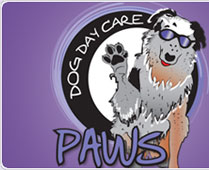Handling Groups Of Dogs In Dog Daycare
![]() Control Begins With Understanding
Control Begins With Understanding
One of the many things that you will need to understand before opening a Dog Daycare is that you will be dealing with large groups of dogs that are primarily guided by instinctual pack behavior. It is extremely important that you understand this if you want to keep the environment safe for you, your staff and your guests.
The other aspect is that although this domesticated pack is primarily guided by thousands of years of evolution and instinct, it is still made up of many individual personalities. You will have dogs of all varieties and all personalities utilizing your facility on a daily basis, and no two days will ever be the same. Your singular goal is to ensure that this domesticated Daycare pack of ever changing dogs from all walks of life with different life experiences gets along and plays nice. The only way to accomplish the goal of having everyone interact peacefully and socially is for you to think like a dog and not expect them to think like a human.
The first step in thinking like a dog is to understand the six general personality types that dog’s exhibit and how each personality interacts with the others. Once you understand this you will be much more capable of identifying each type as they come into your facility and have a greater understanding of how they interact with each and interact with the pack as a whole.
![]() The Six General Personality Types: (Click on a type)
The Six General Personality Types: (Click on a type)
Personality Compatibility Chart
| Aggressive | Confident | Outgoing | Adaptable | Insecure | Independent | |
| Aggressive | Low | Low | Low | Moderate | Low | Moderate |
| Confident | Low | Moderate | High | High | Low | High |
| Outgoing | Low | Moderate | High | High | Low | High |
| Adaptable | Moderate | High | High | High | High | High |
| Insecure | Low | Low | Low | High | High | High |
| Independent | Moderate | Moderate | Moderate | High | High | High |
Now that you have had a chance to gain a greater understanding of the six basic personality types it is time to learn how to interact with the pack as a whole.
![]() Interacting With The Pack
Interacting With The Pack
The most important attribute that you can posses when dealing with large groups of dogs is confidence. You need to be sure that you can control them and they need to be sure that you are in charge at all times. This is not to say that you need to act like an Ogre or be overly dominant but you must be able to maintain control of the pack at all times. You need to be constantly watchful, observing how each personality is interacting with the next, constantly looking for conflicts or for signs that conflict is about to erupt. You will come to find that certain dogs will have personality conflicts and will need to be separated or placed in separate play areas. This is just part of the business and even though both dogs may individually get along with every other member of the pack, they may only have issue with each other.
You need to have the confidence that you can play with them as a group and still be ever watchful of all that is going on while maintaining total control of the situation. You must remember that these are dogs and that they are not only a product of their individual upbringings but are guided by thousands of years of instinct. If you fail to maintain control and put forth a positive but firm image the potential for conflict increases dramatically.
![]() The Truth About Fights
The Truth About Fights
Another very real part of the dog daycare business is that no matter how hard you try, how close you supervise, or how thorough and detailed your screening process there are going to be fights. It is just part of the business and goes back to the dogs being guided by instinct and having to establish themselves at a certain position within the pack. Remember you can only minimize the risk for a fight not eliminate it and one way to minimize this risk is to be able to recognize the signs and stop it them before a fight erupts that could lead to a dog in your care becoming seriously injured. You also need to know how to break up a fight when one occurs, and you need to know how to do this without getting injured in the process. Remember that in an environment such as dog daycare you need to be able to recognize the signs well before the start of a fight as you are not in an environment with just two dogs you are in an environment with multiple dogs, and one fight can trigger others creating a potentially disastrous situation.
The one positive aspect of this instinctual pack behavior is that these fights are rarely engaged in with the motive of causing serious bodily injury or death. The majority of these fights even though they may look viscous and out of control are really nothing more than just tough talk and ways to establish themselves within the pack, and if broken up in a timely fashion rarely result in serious injury. The key thing to keep in mind is that dogs are first cousins to the wolf, and that pack survival depends on having able bodied members to hunt, it would be non beneficial for the survival of the pack as a whole for each conflict to result in serious injury. This would seriously lessen the packs ability to hunt and find food to sustain itself as all the dominant and strong members of the pack (the ones likely to be engaged in pecking order disputes) would be on injured reserve leaving only the weaker members of the pack available for hunting food resources. Although serious fights can happen, the majority will not result in serious injury. Even with this in mind you still need to be able to correctly identify the body language the precipitates a fight.
![]() Basic Behavior To Watch For: (Click on a type)
Basic Behavior To Watch For: (Click on a type)
Now that you know what body language precipitates a fight, let discuss how to safely break one up once started. The reality of the situation is that true fights between dogs are brutal, savage, loud and violent events, where the goal of each animal is to use its main weapon its teeth to force the other dog into submission. It would be foolish to tell you that you will be able to stop every fight before injury occurs; this is unlikely as dogs have had the benefit of many thousands of years of evolution to turn them into effective predators with finely developed weapons to immobilize and kill prey quickly.
When a serious fight takes place and these weapons are used against each other gashes, punctures and other wounds occur within tenths of seconds and the only thing that you can do is to stop it before too much damage is inflicted. I tell you this because even with lightning quick reflexes that break it up quickly you may still be unable to prevent a dog from needing medical treatment. The last piece of very real information that I want to give you before discussing techniques to break up dog fights is that there is a very real possibility that you may get bit during the process.
Consider it an occupational hazard that you are expected and paid to deal with. The dogs are at that moment in a state of high "fight drive" and are entirely focused on the other dog, they may not feel pain, they will not respond to commands and may have no awareness of anything around them. If someone grabs them there is a real possibility that they will bite without even thinking about who or what they are biting. As with any profession that deals with animals you can only minimize certain risks, never eliminate them.
![]() Breaking up Fights
Breaking up Fights
Alright, on to the actual techniques to break up fights. The absolute safest way to break up a dogfight requires 2 people, with each individual grabbing the rear legs of one of the dogs in the fight and lifting the feet off the ground similar to a wheel barrow. With the rear legs elevated and off the ground the dogs are then pulled apart. After they release each other it is important that you do not release the dogs or the fight may begin again with both dogs rushing back after each other. The next phase is for each individual to start turning a circle while backing away from each other maintaining control of the hind legs forcing the dog to sidestep or fall on its face, thus preventing the dog from curling around and coming back to bite the person holding their legs. Lastly both of the dogs needs to be removed from the situation entirely and placed in a secure area away from each other and the other dogs in the area (i.e. a kennel, a timeout area, the grooming room) before releasing either.
The next best way is my least favorite -the one person method. This method is dangerous but depending upon the situation and the location of your staff at times it may be a necessity. The first step is to remain calm and enter the situation without fear and grab the aggressor’s collar and twist it tightly while pulling back in a calm manner. Once you have a firm grip on the aggressor's collar, behind it's head, apply backwards tension and movement telling them “no” and "stop." This needs to be said in a calm, firm, and forceful not panicked or excited tone. If the other dog involved continues attempts to escalate the situation, give a firm command to “stop” or “no” and use whatever means necessary to keep it from coming back at the other dog you are now holding.
The point is to totally dominate both of them with your presence while not getting involved in the actual fight itself. Both animals need to know that you are in charge and that you have final say over everything within the pack to include them, and that you are not afraid. This will at times totally end the situation with both animals demonstrating submissive behavior towards you (the pack leader or Alpha). The most important thing is that you are able to remain calm, confident, and in control.
Other methods include tossing water on them, if you have a dog daycare you may have time to grab the group water dish and douse them. This is actually rather effective for minor altercations. Another alternative to this would be to keep a Super Soaker water gun handy and blast them with that in the event that a fight erupts as it tends to break their concentration and change their focus giving you a chance to intercede and take control of the situation.
Now for the things that you do not want to do as they can put you unnecessarily at risk or exacerbate the situation.
-
Do not try to grab either dog by the mouth, ears, tail or snout. None of these are solid points that you can use to control the dog which may result in the dog you grab wriggling loose and biting you, and all of these points will put your hands and arms directly in the line of fire by the other dog.
-
Do not try to punch, kick, slam, smack, or anything along those lines to get the dogs separated, you are only adding more aggression to an already serious situation and either dog may choose you as the next target if it feels as though it’s being attacked by you.
-
Do not yell, scream or act excited, Some dogs will become even more frightened, angry, or confused if you run in yelling and screaming, making the dog want to fight even more
Purchase the entire 217 page Dog Daycare Start Up Manual
(Instant download upon checkout)
$24.99
All products are available for instant download upon checkout
No products are shipped or otherwise available in hardcopy or paperback form




